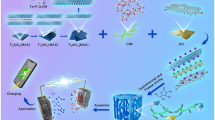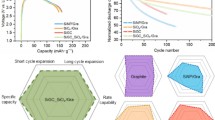Abstract
Silicon is considered an exceptionally promising alternative to the most commonly used material, graphite, as an anode for next-generation lithium-ion batteries, as it has high energy density owing to its high theoretical capacity and abundant storage. Here, microsized walnut-like porous silicon/reduced graphene oxide (P-Si/rGO) core–shell composites are successfully prepared via in situ reduction followed by a dealloying process. The composites show specific capacities of more than 2,100 mAh·g−1 at a current density of 1,000 mA·g−1, 1,600 mAh·g−1 at 2,000 mA·g−1, 1,500 mAh·g−1 at 3,000 mA·g−1, 1,200 mAh·g−1 at 4,000 mA·g−1, and 950 mAh·g−1 at 5,000 mA·g−1, and maintain a value of 1,258 mAh·g−1 after 300 cycles at a current density of 1,000 mA·g−1. Their excellent rate performance and cycling stability can be attributed to the unique structural design: 1) The graphene shell dramatically improves the conductivity and stabilizes the solid–electrolyte interface layers; 2) the inner porous structure supplies sufficient space for silicon expansion; 3) the nanostructure of silicon can prevent the pulverization resulting from volume expansion stress. Notably, this in situ reduction method can be applied as a universal formula to coat graphene on almost all types of metals and alloys of various sizes, shapes, and compositions without adding any reagents to afford energy storage materials, graphene-based catalytic materials, graphene-enhanced composites, etc.

Similar content being viewed by others
References
Seo, M. H.; Park, M.; Lee, K. T.; Kim, K.; Kim, J.; Cho, J. High performance Ge nanowire anode sheathed with carbon for lithium rechargeable batteries. Energy Environ. Sci. 2011, 4, 425–428.
Hassoun, J.; Derrien, G.; Panero, S.; Scrosati, B. A nanostructured Sn–C composite lithium battery electrode with unique stability and high electrochemical performance. Adv. Mater. 2008, 20, 3169–3175.
Zhou, G. M.; Pei, S. F.; Li, L.; Wang, D. W.; Wang, S. G.; Huang, K.; Yin, L. C.; Li, F.; Cheng, H. M. A graphenepure- sulfur sandwich structure for ultrafast, long-life lithiumsulfur batteries. Adv. Mater. 2014, 26, 625–631.
Liu, Q. C.; Xu, J. J.; Yuan, S.; Chang, Z. W.; Xu, D.; Yin, Y. B.; Li, L.; Zhong, H. X.; Jiang, Y. S.; Yan, J. M. et al. Artificial protection film on lithium metal anode toward long-cycle-life lithium-oxygen batteries. Adv. Mater. 2015, 27, 5241–5247.
Jansen, A. N.; Kahaian, A. J.; Kepler, K. D.; Nelson, P. A.; Amine, K.; Dees, D. W.; Vissers, D. R.; Thackeray, M. M. Development of a high-power lithium-ion battery. J. Power Sources 1999, 81–82, 902–905.
Wang, W.; Ruiz, I.; Ahmed, K.; Bay, H. H.; George, A. S.; Wang, J.; Butler, J.; Ozkan, M.; Ozkan, C. S. Silicon decorated cone shaped carbon nanotube clusters for lithium ion battery anodes. Small 2014, 10, 3389–3396.
Liu, N.; Hu, L. B.; McDowell, M. T.; Jackson, A.; Cui, Y. Prelithiated silicon nanowires as an anode for lithium ion batteries. ACS Nano 2011, 5, 6487–6493.
Park, M. H.; Kim, M. G.; Joo, J.; Kim, K.; Kim, J.; Ahn, S.; Cui, Y.; Cho, J. Silicon nanotube battery anodes. Nano Lett. 2009, 9, 3844–3847.
Du, F. H.; Bo, L.; Wei, F.; Xiong, Y. J.; Wang, K. X.; Chen, J. S. Surface binding of polypyrrole on porous silicon hollow nanospheres for Li-ion battery anodes with high structure stability. Adv. Mater. 2014, 26, 6145–6150.
Chen, Y.; Liu, L. F.; Xiong, J.; Yang, T. Z.; Qin, Y.; Yan, C. L. Porous Si nanowires from cheap metallurgical silicon stabilized by a surface oxide layer for lithium ion batteries. Adv. Funct. Mater. 2015, 25, 6701–6709.
Ge, M. Y.; Rong, J. P.; Fang, X.; Zhang, A. Y.; Lu, Y. H.; Zhou, C. W. Scalable preparation of porous silicon nanoparticles and their application for lithium-ion battery anodes. Nano Res. 2013, 6, 174–181.
Lv, Q. L.; Liu, Y.; Ma, T. Y.; Zhu, W. T.; Qiu, X. P. Hollow structured silicon anodes with stabilized solid electrolyte interphase film for lithium-ion batteries. ACS Appl. Mater. Interfaces 2015, 7, 23501–23506.
Wang, C.; Wu, H.; Chen, Z.; Mcdowell, M. T.; Cui, Y.; Bao, Z. N. Self-healing chemistry enables the stable operation of silicon microparticle anodes for high-energy lithium-ion batteries. Nat. Chem. 2013, 5, 1042–1048.
Zhao, H.; Du, A.; Ling, M.; Battaglia, V.; Liu, G. Conductive polymer binder for nano-silicon/graphite composite electrode in lithium-ion batteries towards a practical application. Electrochim. Acta 2016, 209, 159–162.
Kovalenko, I.; Zdyrko, B.; Magasinski, A.; Hertzberg, B.; Milicev, Z.; Burtovyy, R.; Luzinov, I.; Yushin, G. A major constituent of brown algae for use in high-capacity Li-ion batteries. Science 2011, 334, 75–79.
Leung, K.; Rempe, S. B.; Foster, M. E.; Ma, Y. G.; Martinez del la Hoz, J. M.; Sai, N.; Balbuena, P. B. Modeling electrochemical decomposition of fluoroethylene carbonate on silicon anode surfaces in lithium ion batteries. J. Electrochem. Soc. 2014, 161, A213–A221.
Qiao, L.; Sun, X. L.; Yang, Z. B.; Wang, X. H.; Wang, Q.; He, D. Y. Network structures of fullerene-like carbon core/nano-crystalline silicon shell nanofibers as anode material for lithium-ion batteries. Carbon 2013, 54, 29–35.
Ng, S. H.; Wang, J. Z.; Wexler, D.; Chew, S. Y.; Liu, H. K. Amorphous carbon-coated silicon nanocomposites: A lowtemperature synthesis via spray pyrolysis and their application as high-capacity anodes for lithium-ion batteries. J. Phys. Chem. C 2007, 111, 11131–11138.
Chen, P. C.; Xu, J.; Chen, H. T.; Zhou, C. W. Hybrid siliconcarbon nanostructured composites as superior anodes for lithium ion batteries. Nano Res. 2011, 4, 290–296.
Kim, T.; Mo, Y. H.; Nahm, K. S.; Oh, S. M. Carbon nanotubes (CNTs) as a buffer layer in silicon/CNTs composite electrodes for lithium secondary batteries. J. Power Sources 2006, 162, 1275–1281.
Kim, W. S.; Choi, J; Hong, S. H. Meso-porous silicon-coated carbon nanotube as an anode for lithium-ion battery. Nano Res. 2016, 9, 2174–2181.
Li, N.; Jin, S. X.; Liao, Q. Y.; Cui, H.; Wang, C. X. Encapsulated within graphene shell silicon nanoparticles anchored on vertically aligned graphene trees as lithium ion battery anodes. Nano Energy 2014, 5, 105–115.
Ding, X. L.; Liu, X. X.; Huang, Y. Y.; Zhang, X. F.; Zhao, Q. J.; Xiang, X. H.; Li, G. L.; He, P. F.; Wen, Z. Y.; Li, J. et al. Enhanced electrochemical performance promoted by monolayer graphene and void space in silicon composite anode materials. Nano Energy 2016, 27, 647–657.
Zhou, X. S.; Cao, A. M.; Wan, L. J.; Guo, Y. G. Spin-coated silicon nanoparticle/graphene electrode as a binder-free anode for high-performance lithium-ion batteries. Nano Res. 2012, 5, 845–853.
Geim, A. K.; Novoselov, K. S. The rise of graphene. Nat. Mater. 2007, 6, 183–191.
Hu, C. G.; Zhai, X. Q.; Liu, L. L.; Zhao, Y.; Jiang, L.; Qu, L. T. Spontaneous reduction and assembly of graphene oxide into three-dimensional graphene network on arbitrary conductive substrates. Sci. Rep. 2013, 3, 2065.
Lee, S. H.; Park, S.; Min, K.; Yoon, D.; Chanthad, C.; Cho, M.; Kim, J.; Park, J. H.; Lee, Y. Supercritical carbon dioxideassisted process for well-dispersed silicon/graphene composite as a Li ion battery anode. Sci. Rep. 2016, 6, 32011.
Ren, W. F.; Zhang, Z. L.; Wang, Y. H.; Tan, Q. Q.; Zhong, Z. Y.; Su, F. B. Preparation of porous silicon/carbon microspheres as high performance anode materials for lithium ion batteries. J. Mater. Chem. A 2015, 3, 5859–5865.
Dreyer, D. R.; Park, S.; Bielawski, C. W.; Ruoff, R. S. The chemistry of graphene oxide. Chem. Soc. Rev. 2010, 39, 228–240.
Guo, Y. Q.; Sun, X. Y.; Liu, Y.; Wang, W.; Qiu, H. X.; Gao, J. P. One pot preparation of reduced graphene oxide (RGO) or Au (Ag) nanoparticle-RGO hybrids using chitosan as a reducing and stabilizing agent and their use in methanol electrooxidation. Carbon 2012, 50, 2513–2523.
Fan, Z. J.; Wang, K.; Wei, T.; Yan, J.; Song, L. P.; Shao, B. An environmentally friendly and efficient route for the reduction of graphene oxide by aluminum powder. Carbon 2010, 48, 1686–1689.
Yao, F.; Güneş, F.; Ta, H. Q.; Lee, S. M.; Chae, S. J.; Sheem, K. Y.; Cojocaru, C. S.; Xie, S. S.; Lee, Y. H. Diffusion mechanism of lithium ion through basal plane of layered graphene. J. Am. Chem. Soc. 2012, 134, 8646–8654.
Wang, G. X.; Yang, J.; Park, J.; Gou, X. L.; Wang, B.; Liu, H.; Yao, J. Facile synthesis and characterization of graphene nanosheets. J. Phys. Chem. C 2008, 112, 8192–8195.
Rathnayake, R. M. N. M.; Wijayasinghe, H. W. M. A. C.; Pitawala, H. M. T. G. A.; Yoshimura, M.; Huang, H. H. Synthesis of graphene oxide and reduced graphene oxide by needle platy natural vein graphite. Appl. Surf. Sci. 2017, 393, 309–315.
Yan, M. Y.; Wang, F. C.; Han, C. H.; Ma, X. Y.; Xu, X.; An, Q. Y.; Xu, L.; Niu, C. J.; Zhao, Y. L.; Tian, X. C. et al. Nanowire templated semihollow bicontinuous graphene scrolls: Designed construction, mechanism, and enhanced energy storage performance. J. Am. Chem. Soc. 2013, 135, 18176–18182.
Zhao, Y. L.; Feng, J. G.; Liu, X.; Wang, F. C.; Wang, L. F.; Shi, C. W.; Huang, L.; Feng, X.; Chen, X. Y.; Xu, L. et al. Self-adaptive strain-relaxation optimization for high-energy lithium storage material through crumpling of graphene. Nat. Commun. 2014, 5, 4565.
Li, Y. Z.; Yan, K.; Lee, H. W.; Lu, Z. D.; Liu, N.; Cui, Y. Erratum: Growth of conformal graphene cages on micrometresized silicon particles as stable battery anodes. Nat. Energy 2016, 1, 16017.
Liu, X. H.; Zhang, L. Q.; Zhong, L.; Liu, Y.; Zheng, H.; Wang, J. W.; Cho, J. H.; Dayeh, S. A.; Picraux, S. T.; Sullivan, J. P. et al. Ultrafast electrochemical lithiation of individual Si nanowire anodes. Nano Lett. 2011, 11, 2251–2258.
Su, X.; Wu, Q. L.; Li, J. C.; Xiao, X. C.; Lott, A.; Lu, W. Q.; Sheldon, B. W.; Wu, J. Silicon-based nanomaterials for lithium-ion batteries: A review. Adv. Energy Mater. 2014, 4, 1300882.
Chan, C. K.; Peng, H. L.; Liu, G.; Mcilwrath, K.; Zhang, X. F.; Huggins, R. A.; Cui, Y. High-performance lithium battery anodes using silicon nanowires. Nat. Nanotechnol. 2008, 3, 31–35.
Nyman, A.; Zavalis, T. G.; Elger, R.; Behm, M.; Lindbergh, G. Analysis of the polarization in a Li-ion battery cell by numerical simulations. J. Electrochem. Soc. 2010, 157, A1236–A1246.
Maroni, F.; Raccichini, R.; Birrozzi, A.; Carbonari, G.; Tossici, R.; Croce, F.; Marassi, R.; Nobili, F. Graphene/silicon nanocomposite anode with enhanced electrochemical stability for lithium-ion battery applications. J. Power Sources 2014, 269, 873–882.
Klankowski, S. A.; Pandey, G. P.; Cruden, B. A.; Liu, J. W.; Wu, J.; Rojeski, R. A.; Li, J. Anomalous capacity increase at high-rates in lithium-ion battery anodes based on siliconcoated vertically aligned carbon nanofibers. J. Power Sources 2015, 276, 73–79.
Acknowledgements
This work was supported by the 1000 Talent Plan program (No. 31270086963030), Key Research Plan of Shandong Province (No. 2015GGE27286), Independent Innovation Foundation of Shandong University, and the Young Scholars Program of Shandong University (No. 2016WLJH03).
Author information
Authors and Affiliations
Corresponding authors
Electronic supplementary material
12274_2017_1584_MOESM1_ESM.pdf
Walnut-inspired microsized porous silicon/graphene core–shell composites for high-performance lithium-ion battery anodes
Rights and permissions
About this article
Cite this article
Zhai, W., Ai, Q., Chen, L. et al. Walnut-inspired microsized porous silicon/graphene core–shell composites for high-performance lithium-ion battery anodes. Nano Res. 10, 4274–4283 (2017). https://doi.org/10.1007/s12274-017-1584-5
Received:
Revised:
Accepted:
Published:
Issue Date:
DOI: https://doi.org/10.1007/s12274-017-1584-5




